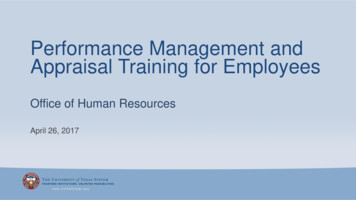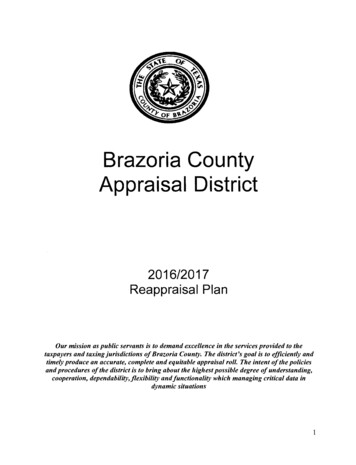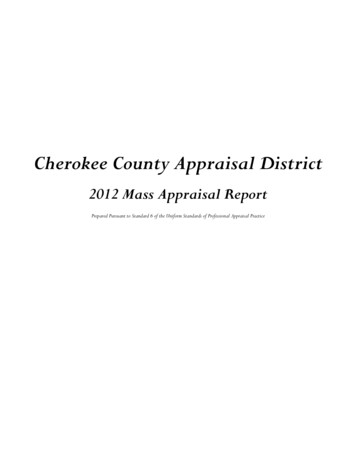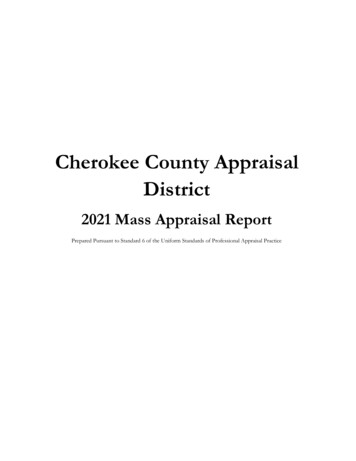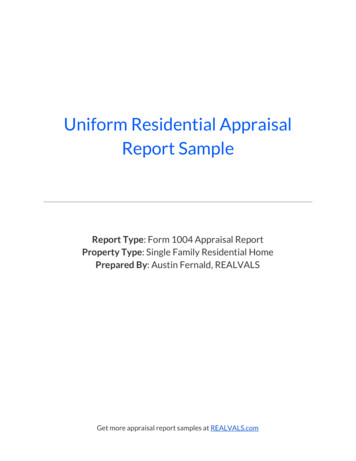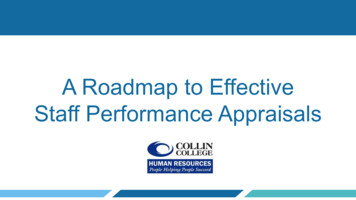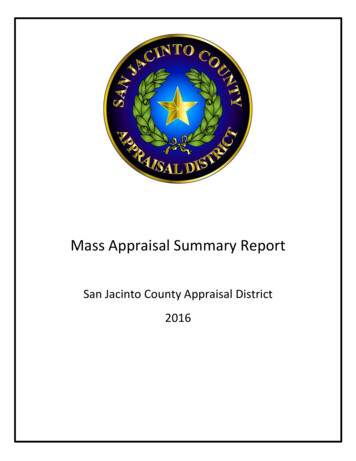
Transcription
Mass Appraisal Summary ReportSan Jacinto County Appraisal District2016
San Jacinto County Appraisal District2016 Annual Mass Appraisal ReportTABLE OF CONTENTSIntroduction . 2Assumptions and Limiting Conditions . 3USPAP . 4Valuation Approach . 6Market ValueArea Analysis . 7Overview of Types of Properties Appraised . 7Highest and Best Use Analysis .9Market Analysis. 9Data Collection and Validation . 11Data Collection and Sources . 10Valuations Analysis . 13Residential Schedules . 14Commercial Schedules . 14Personal Property Schedules . 15Statistical Analysis . 16Individual Value Review Procedures. 17Performance Tests . 18Staff Performing Significant Mass Appraisal Assistance . 19Certification Statement. 201
San Jacinto County Appraisal District2016 Annual Mass Appraisal ReportINTRODUCTIONThe purpose of this summary report is to aid the taxpaying public in betterunderstanding the methods and techniques utilized by the San Jacinto County Appraisal District(SJCAD) in the valuation and revaluation of taxable property within San Jacinto County. Thisreport attempts to comply with Standard 6 of the Uniform Standards of Professional AppraisalPractice (USPAP). San Jacinto CAD maintains detailed appraisal manuals for appraisal use.San Jacinto CAD is a central Appraisal District formed by the Texas Legislature in 1979and is charged with the appraisal of all taxable property within the District’s boundaries.Covering 571 square miles in the East Texas Timberland Region, 60 percent of San JacintoCounty is located in the Sam Houston National Forest. San Jacinto CAD consists of eleven taxingentities named below:San Jacinto CountyWillis Independent School DistrictCleveland Independent School DistrictColdspring-Oakhurst Independent School DistrictShepherd Independent School DistrictLone Star College-KingwoodCity of ShepherdWaterwood MUDCape Royale MUDSan Jacinto Consolidated ESDCity of ClevelandCurrent state law, set out in Section 6.02 (a) of the Texas Property Tax Code, mandatesthat appraisal district boundaries are the same as the county’s boundaries.2
San Jacinto County Appraisal District2016 Annual Mass Appraisal ReportASSUMPTIONS AND LIMITING CONDITIONSSan Jacinto CAD has taken reasonable steps to secure adequate funding; however fiscalrestraints do impact the mass appraisal process. Limited resources and limited personnel areavailable to perform the appraisal. Therefore, it is not possible to physically inspect everyproperty included on the appraisal roll. When physical inspections were conducted on realproperty, they were generally performed with exterior review only. It is assumed that theinterior conditions are consistent with the exterior conditions. When physical inspections weremade for eth valuation of personal property, inspections were made of the entire facility ifallowed by the owner or management of the business.This mass appraisal has been made under the following assumptions and limitingconditions: It is assumed that the title to each property is good and merchantable.No liability is assumed for matters of a legal nature.Assumptions made in the report are based on the best knowledge and judgment of theappraiser and are believed to be typical of the market.All properties are appraised as if free and clear of any or all liens or encumbrances,unless otherwise stated.Existence of hazardous materials or other adverse environmental conditions are notconsidered, unless otherwise indicated.Any drawings, photographs, plan, or plats are assumed to be correct and are includedsolely to assist in visualizing the property.It is assumed that there is full compliance with all applicable federal, state, and localregulations and laws, unless otherwise noted.No responsibility is assumed for hidden or unapparent conditions in the property thatmay affect its value.It is assumed that all required licenses, certificates of occupancy, consents or otheradministrative authority from local, state, or federal governments can be obtained orrenewed for any use on which the value estimate contained in this report is based.A specific survey and analysis of properties to determine compliances with theprovisions of the Americans with Disabilities Act has not been performed and possiblenon-compliance has not been considered in valuing these properties.While it is believed all information included in the appraisal is correct and accurate, theappraiser does not guarantee such.This report may not be used for any purpose or by any person other than the party towhich it is addressed without the written permission of the San Jacinto CAD.3
San Jacinto County Appraisal District2016 Annual Mass Appraisal ReportUSPAPThe chief appraiser is the chief administrative and executive officer of the appraisaldistrict. The chief appraiser employees and directs the district’s staff, oversees all aspects ofthe appraisal district’s operations and performs either directly or through the district staffvariety of operations. The district employs eight staff who are subject to the provisions of theProperty Taxation Professional Certification Act and must be duly registered with the TexasDepartment of Licensing and Regulation (TDLR). Support functions including recordsmaintenance, information and assistance to property owners, and hearings are coordinated bypersonnel in support services.The chief appraiser’s appraisal responsibilities include:1. Discover, list, and appraisal all property within the CAD.2. Determine exemptions and special use requests3. Organize periodic reappraisals4. Notify taxpayers, taxing units, and public about matters that affect propertyvaluesSan Jacinto CAD contracts with Hugh L. Landrum & Associates, Inc. an appraisal firm, toappraise minerals, industrial plants, pipelines, industrial personal property, and utilities withinthe boundaries of the appraisal district. The district uses computer software provided by HarrisGovern for the data processing of all appraisal records, records management system, andmaintenance of the digitized mapping system.4
San Jacinto County Appraisal District2016 Annual Mass Appraisal ReportAs of May 2016 the appraisal roll for San Jacinto County Appraisal district indicates atotal of 40,822 parcels. The breakdown by category is as Real Property: Single-Family Residential . 9209Real Property: Multifamily Residential . 14Vacant Lots . . 14,979Qualified Open-Space Land. 2,984Improvements on Qualified Open Space . 180Rural Land, Non-Qualified Open Space . 7,740Real Property: Commercial . 525Industrial and Manufacturing Real . 2Real Property: Oil, Gas and Other Minerals . 1,139Water Systems . 6Gas Distribution System . 3Electric Company (Including Co-Op) . 21Telephone Company (Including Co-Op) . 16Railroad . . 3Pipelines . . 50Cable Television Company . 11Other Utilities . .4Railroad Rolling Stock . 1Personal Property: Commercial . 458Industrial and Manufacturing Personal Property . 107Mobile Homes . 1,688Real Property: Residential Inventory . 946Special Inventory. 2Totally Exempt Property . 2,184(Some parcels will fall into multiple categories)5
San Jacinto County Appraisal District2016 Annual Mass Appraisal ReportVALUATION APPROACHMARKET VALUEMarket value for purposes of this mass appraisal is defined by the Texas Property TaxCode, §1.04(7), which states:“Market Value” means that price at which a property would transfer for cash orits equivalent under prevailing market conditions if:A. Exposed for sale in the open market with a reasonable time for the sellerto find a purchaser;B. Both the seller and the purchaser know of all the uses and purposes towhich the property is adapted and for which it is capable of being usedand of the enforceable restrictions on its use; andC. Both the seller and purchaser seek to maximize their gains and neither isin a position to take advantage of the exigencies of the other.In regards to inventory held as part of a business, §23.12(a) of the Texas Property TaxCode further provides, in part; “the market value of an inventory is the price for which it wouldsell as a unit to a purchaser who would continue the business.”The effective date of appraisals is January 1, with the exemption of inventory, whichmay be appraised at its market value as of September 1. To receive the September 1 appraisaldate, a taxpayer must file an application by July 31.The purpose of and intended use of the appraisals performed by the San Jacinto CountyAppraisal District is to estimate market value for ad valorem tax purposes for the taxing entitieslocated within the boundaries of San Jacinto County Appraisal District. It is the goal of the staffof the San Jacinto County Appraisal District to provide the best possible service to the taxpaying public and the taxing entities. The San Jacinto County Appraisal District staff promotesand adheres to the professional standards and ethics as set forth by the Texas Department ofLicensing and Regulation, Texas Association of Appraisal Districts, Texas Association ofAssessing Officers, and the International Association of Assessing Officers (IAAO).6
San Jacinto County Appraisal District2016 Annual Mass Appraisal ReportAREA ANALYSISOverview of Types of Properties AppraisedThere are three major categories of property appraised by the San Jacinto CountyAppraisal District. These categories are:1. Real:a. Residential (both single family and multi-family)b. Commercial/Industrialc. Vacant Lots (both residential and commercial)d. Vacant rural land and improvements on rural land2. Personal:a. Income producing business personal propertyb. Industrial personal properties3. Minerals:a. Oil and Gas4. Utilities:a. Telephone companiesb. Cable companiesc. Electrical companiesd. Fiber opticse. Railroadsf. Pipelinesg. Misc. other utilitiesThe Property Tax Assistance Division of the State Comptroller’s Office requires properties to beidentified by type using a standard identification code. The codes currently used by the SanJacinto County Appraisal District are as follows:AReal Property: Single-Family ResidentialBCDD2Real Property: Multifamily ResidentialReal Property: Vacant Lots and TractsReal Property: Qualified Agricultural LandReal Property: Improvements on Qualified AG LandReal Property: Rural Land, Not qualified for open-space land appraisal, andImprovementsReal Property: CommercialReal Property: Industrial (Manufacturing)Real Property: Oil, Gas and Other MineralsWater SystemsGas Distribution SystemElectric Company (Including Co-Op)EF1F2G1J1J2J37
San Jacinto County Appraisal District2016 Annual Mass Appraisal ReportJ4Telephone Company (Including Co-Op)J5J6J7J8J9L1RailroadPipeline CompanyCable Television CompanyOther UtilitiesRailroad Rolling StockPersonal Property: CommercialL2M1OSXPersonal Property: Industrial (Manufacturing)Mobile HomesReal Property: Residential InventorySpecial InventoryTotally Exempt Property8
San Jacinto County Appraisal District2016 Annual Mass Appraisal ReportHIGHEST AND BEST USE ANALYSISThe highest and best use of real estate is defined as the most reasonable and probablyuse of land that will generate the highest return to the property over a period of time. This usemust be legal, physically possible, economically feasible, and the most profitable of thepotential uses. The appraiser’s identification of a property’s highest and best use is always astatement of opinion, never a statement of fact.In order to complete the highest and best use analysis of a property, the appraiser mustestimate the highest and best use as if the land were vacant. This estimate ignores the value ofand the restrictions created by existing improvements. It is the highest value the land couldhave if it were available for any legal, physically possible, and economically feasible kind ofdevelopment.In determining the highest and best use, preliminary judgments are made in the field bythe appraiser. The appraiser is normally aware of zoning regulations within physical boundariesof the county.San Jacinto County Appraisal District property appraisal cards contain informationregarding lot size and frontage that allow the appraiser to make judgments on the highest andbest use of sites in the field. Economically feasible and most profitable uses are determined byobserving surrounding property. However, changes in property use require a more detailedand technical highest and best use analysis. These studies are performed in the office.MARKET ANALYSISNational, regional, and local trends affect the universe of properties appraised in SanJacinto County. An awareness of social, economic, governmental, and environmentalconditions is essential in understanding, analyzing, and identifying local trends that affect thereal estate market.9
San Jacinto County Appraisal District2016 Annual Mass Appraisal ReportMarket analysis is performed throughout the year. Both general and specific data iscollected and analyzed. An in-house ratio study is conducted at least once a year.Examples of sources of general data include “Trends” issued by The Real Estate Centerat Texas A&M University, “The Appriser” published by The Texas Association of AppraisalDistricts, and the “Texas Assessor’s News” published by the Texas Association of AssessingOfficers. When possible, local sources such as lending institutions, local realtors, the Chamberof Commerce, and articles published in the local and area newspaper are used to obtainfinancing information, market trends and information, demographics, and labor statistics.Sales information is received from various sources. Sales confirmation letters are mailedto each buyer and seller when a property changes hands. In addition, sales information isobtained from local realtors, fee/land appraisers, and lending institutions.County deed records are regularly checked or new real estate transactions. San JacintoCAD uses county deed records to generate sale confirmation letters for each buyer and seller toobtain detailed information on the sale. Because full sales disclosure is not mandatory in theState of Texas only a small percentage of letters are returned with useful information. This is aserious problem in that there is usually inadequate sales data to perform as thorough ananalysis of sales data as USPAP would require. However, ever effort is made to use what data isavailable. The property Tax Assistance division also sends out sales letters and that data ismade available to the appraisal district at least once a year.San Jacinto County Appraisal District currently, within time and budget constraints, doesreappraisals on a three-year basis. The reappraisal includes the inspection of properties andthe updating of all information on the properties. Sales and market analysis are performedeach year on residential properties, as information is available. Each year new properties areinspected, measured, and added to the roll. In addition, building permits are obtained andchanges to property records are made accordingly. Individual properties are also reappraisedwith changes to the condition as the property warrants; for example, fire, remodeling, or anaddition or demolition of a portion of the improvement. Refer to the San Jacinto Appraisal10
San Jacinto County Appraisal District2016 Annual Mass Appraisal ReportDistrict Re-Appraisal Plan for year 2015-2016 for further information on reappraisalrequirements.When performing field work, the appraiser carries property record cards that containspecific information regarding the property being appraised. These cards contain brief legaldescriptions, ownership interests, property use codes, property addresses, land size, sketchesof improvements as well as any available detailed information of the improvements. A copy ofa property record card may be obtained at the appraisal office.Field inspections require the appraiser to check all information on the property recordcards and to update if necessary. If physical inspection of the property indicates changes toimprovements, the appraiser notes these changes in the field. Examples of types of changesmay be condition or effect age of the improvements as well as additions to the improvements.The classification of residential properties is also reviewed during the revaluation process. Newimprovements are also added at this time.DATA COLLECTION AND VALIDATIONSan Jacinto County Appraisal District cost and value schedules include land andresidential improvements. Residential schedules are built and maintained using current market(sales) data. Commercial schedules were developed by using information from Marshall &Swift Valuation Services using local factor adjustments and adjusted using valid markettransactions in the area. Personal property schedules reflect information obtained fromnational valuation publications, such as Marshal and Swift, business personal propertyrenditions, and on-site inspections. Marshall & Swift valuation Services is nationally recognizedsource for residential, commercial, and personal property cost schedules. Cost manuals arebased on cost per square foot and also the unit in place method. The unit in place methodinvolves estimating cost by using actual building components. Marshall & Swift provides thebase price of buildings as per classification with modifications for equipment and additional11
San Jacinto County Appraisal District2016 Annual Mass Appraisal Reportitems. The schedule is then modified for time and location. Business personal propertyrenditions are confidential sources of information field by business owners. However, datafrom rendition may be compared with data from cost manuals and used to test for accuracy.Data on individual properties is also collected from the field, compiled, and analyzed.Buildings and other improvements are inspected in the field, measured, and classified. Theappraiser estimates the age and determines the condition of the improvements. This data isused to compile depreciation (loss of value) tables, and any notes pertaining to theimprovements are made at this time.Currently, single family dwellings are classified for quality and type of construction,whether frame or brick veneer. The classifications range from a class 3 to a class 8. Class 3 isthe most basic of structures using the poorest quality materials and lowest workmanship. AnClass 8 structure is of the highest possible quality using only the best of materials and thehighest and best quality workmanship available. For any dwelling that exceeds the generaldescription of the top-most classification, a special class is assigned.Age of building is used to estimate depreciation and based on effective age of theimprovements. Effective age is the age the property appears to be due to maintenance andupkeep. Effective age for a house that is property maintained may be its actual orchronological age. However, if a structure suffers from deferred maintenance due to neglect,its effective age may be older than the actual age. In contrast, if a house is an older structureand has been remodeled or updated, its effective age may be less than its actual age.Depreciation is also estimated by condition of the improvements. Condition rangesfrom salvage to excellent. Appraisals are based on exterior observations, however, if thetaxpayer requests, an interior inspection may be made.Foundation failure may occur in varying degrees and may also result in loss of value.The appraiser makes allowances for foundation problems on a case by case basis determinedby the cost of the repair.12
San Jacinto County Appraisal District2016 Annual Mass Appraisal ReportAdditional depreciation may be estimated for a variety of reasons including functionalobsolescence results from a loss of value to a property due to adverse influences from outsidethe physical boundaries of the property. Examples on economic obsolescence may beproximity to correctional facilities, location of residences outside city limits with no access tocity amenities, residences located on farm and ranch land, etc.VALUATION ANALYSISSan Jacinto County Appraisal District valuation schedules are divided into three mainclassifications: residential, commercial, and personal property. These schedules are based onthe most current market and cost data available. Miscellaneous special categories such asmobile homes, special inventory, and agricultural land are appraised using different techniques,which are addressed later in this report. Depreciation tables/schedules are also included withinthese schedules. These tables are calibrated from costs as well as sales data and updated asneeded. These tables and schedules are included in San Jacinto CAD’s appraisal manuals. SanJacinto CAD utilizes a properly specified and calibrated computer assisted mass appraisal model(CAMA) developed by its software vendor. The CAMA model values individual propertycharacteristics based on their contributory value to the total property value. Contributoryvalue for each property segment (characteristic) is determined by sales analysis and localbuilding costs. The model accesses appraisal cost schedules for each segment developed andmaintained by San Jacinto CAD and calculates a total market value for each property.13
San Jacinto County Appraisal District2016 Annual Mass Appraisal ReportRESIDENTIAL SCHEDULESResidential valuation schedules are cost based tables modified by actual sales data fromwithin the county. That is, the cost reflects actual replacement cost new of the subjectproperty. Market research indicates that the common unit of comparison for new residentialconstruction as well as sales of existing housing is the price paid per square foot. The value ofextra items is based on their contributory value to the property. This value may be estimatedby the price per square foot or a value of the item as a whole. This data is extracted from themarket by paired sales analysis and conversations with local chief appraisers and brokers.The residential schedule is based on the size, age, and condition of the structure, qualityof construction, contributory value of extra items, and land value. Each of these variables has adirect impact on the cost as well as the property. The following is an example of each of thevariables and how they affect market value:1. Quality of construction: Residential construction may vary greatly in quality ofconstruction. The type of construction, cost of material used, the quality of theworkmanship, and the attention paid to detail all affects the quality. The costand value of residential property will vary greatly depending on the quality of theconstruction. San Jacinto County Appraisal District’s residential schedulescurrently class houses based on quality of construction ranging from Class 8(highest) to Class 3 (lowest). Within class, the CAD can recognize above averageattributes by imposing a plus ( ) factor.2. Size of structure: The size of a structure also has a direct impact on its cost aswell as value. The larger the structure, the less the cost per square foot. SanJacinto County Appraisal District’s schedules are designed using linear regressionbased on square footages.3. Condition of improvements: San Jacinto County Appraisal District captures thecondition of real improvements via its classification codes Poor to Excellent, withPoor being unusable and Excellent representing excellent or superior condition.14
San Jacinto County Appraisal District2016 Annual Mass Appraisal Report4. Age of Structure: Age is the primary factor when determining residentialdepreciation. Effective age and chronological age may be the same or differentdepending on the condition of the structure.5. Extra items: As stated above, extra items are valued according to theircontributory value to the whole. Examples of extra items include storagebuildings, swimming pools, fireplaces, additional baths, etc.6. Land value: San Jacinto County Appraisal district values land based on marketdata. Other recognized methods of land valuation may be used when marketdata is limited. The two most common methods are the land residual methodand the land ratio method. Land schedules are available at the appraisal districtoffice.COMMERCIAL SCHEDULESCommercial properties are valued using valid market transactions in the area, alongwith Marshall and Swift Valuation schedules for commercial property. Replacement cost new isdetermined and then adjusted for location. Depreciation is then applied using physicalobservation of the property.PERSONAL PROPERTY SCHEDULEThe personal property schedules value business furniture, fixtures, and equipment aswells as inventory that are taxable by law. Business vehicles located within the appraisaldistrict boundaries are also appraised for ad valorem tax purposes.Business personal property values are derived from several sources. Business ownersare required by Texas Law to render their income producing personal property each year.Rendered values are used on business personal property if the value is reasonable for the typeof business when compared to similar business renditions and personal property costschedules. Should the rendered values not be accepted, personal property is appraised usingcurrent cost schedules. Value on all business personal property not rendered is established15
San Jacinto County Appraisal District2016 Annual Mass Appraisal Reportusing cost schedules for the type of business being valued. Depreciation is determined by theage of the property and its expected life. Schedules are available in the appraisal district office.Business vehicles are valued based on the NADA Used Car Guide trade-in value for theparticular make, model, and age of the vehicle. The trade-in value may also be obtained from“Car-Point” or other websites available on the internet. When adverse factors such as highmileage are known, then the appropriate adjustments are made to the value. The San JacintoCounty Appraisal District uses data obtained from “Just Texas” for vehicles that registered ascommercial vehicles.STATISTICAL ANALYSISStatistics are a way to analyze data and study characteristics of a collection ofproperties. In general, it is not feasible to study the entire population. Statistics are used totest representative samples of the population.San Jacinto county Appraisal District’s statistical analysis for real estate is based onmeasures of central tendency and measures of variability. The measure of central tendencydetermines the center of a distribution. The measures of central tendency utilized with the aidof computer based programs are the mean, median, mode, and the weighted mean.San Jacinto CAD measures variability by calculating a coefficient of dispersion (COD).The COD is used to indicate the spread from the measure of central tendency. Statistical bias ismeasured by the price related differential (PRD). The PRD indicates how high price propertiesare appraised in relations to low price properties.These statistics are included in the district’s ratio studies and may be obtained from theappraisal office.16
San Jacinto County Appraisal District2016 Annual Mass Appraisal ReportINDIVIDUAL
2016 Annual Mass Appraisal Report 4 USPAP The chief appraiser is the chief administrative and executive officer of the appraisal district. The chief appraiser employees and directs the district’s staff, oversees all aspects of the appraisal district’s operations and performs either dire

